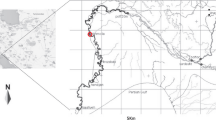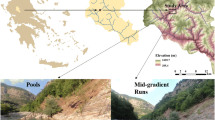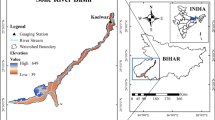Abstract
This research delves into the intricate process of estimating bankfull discharge using proxy parameters for the upper Murti River and Khar Khola, two Himalayan streams. Through five distinct proxy parameter-based approaches, the study reveals a broad spectrum of findings that underscore the complexity inherent in discharge estimation within river systems. For upper Murti River, the lowest discharge value was 10.18 m3s–1, derived through average depth; the highest discharge value was 181.87 m3s–1, estimated based on channel width; and the calculated average discharge was 99.45 m3s–1. The variation in estimated discharge expressed in terms of standard deviation (SD) is 74.76 m3s–1. For Khar Khola, the lowest discharge value was 1.78 m3s–1, derived through average depth; the highest discharge value was 25.12 m3s–1 \(,\) estimated based on basin area; and the average discharge was 11.127 m3s–1. The variation in estimated discharge expressed in terms of standard deviation (SD) is 11.124 m3s–1, almost equal to the average of three estimates. The utilization of specific proxy parameters, such as the largest entrained sediment size and corresponding flow velocity from the Hjulstrom curve, the power relationship between velocity and discharge, basin area, average depth, and channel width underscores the diversity of factors shaping river behavior. The study underscores the significance of comprehending natural complexities and limitations of proxy parameters, and provides valuable insights aimed at refining and responsibly managing discharge estimation methods, thereby enhancing strategies for river management.






Similar content being viewed by others
Data availability
Available on request.
References
Alexander GN (1972) Effect of catchment area on flood magnitude. J Hydrol 16(3):225–240
Ayaz S, Dhali MK (2020) Longitudinal profiles and geomorphic indices analysis on tectonic evidence of fluvial form, process and landform deformation of Eastern Himalayan Rivers, India. Geol Ecol Landsc 4(1):11–22
Bainbridge ZT, Wolanski E, Alvarez-Romero JG, Lewis SE, Brodie JE (2012) Fine sediment and nutrient dynamics related to particle size and floc formation in a Burdekin river flood plume, Australia. Mar Pollut Bull 2012(65):236–248
Berthot L, St-Hilaire A, Caissie D, El-Jabi N, Kirby J, Ouellet-Proulx S (2021) The use of wetted perimeter as habitat proxy to assess environmental flows in Southern Quebec Rivers (Canada). Ecol Ind 132:108283
Biswas B, Das BC (2016) Hydraulic parameters and morphometric variables interaction in bedrock channel. Questions Geographicae, Poland, ISSN: 0137–477X, 35(3): 75–88. https://content.sciendo.com/view/journals/quageo/35/3/article-p75.xml
Bjerklie DM, Dingman SL, Vorosmarty CJ, Bolster CH, Congalton RG (2003) Evaluating the potential for measuring river discharge from space. J Hydrol 278:17–38
Bjerklie DM, Moller D, Smith LC, Dingman SL (2005) Estimating discharge in rivers using remotely sensed hydraulic information. J Hydrol 2005(309):191–209
Brakenridge GR, Nghiem SV, Anderson E, Mic R (2007) Orbital microwave measurement of river discharge and ice status. Water Resour Res 2007:43
Brush LM (1961) Drainage basins, channels, and flow characteristics of selected streams in central Pennsylvania. US Geol Surv Prof Pap 282F:145–181
Cai M, Gao J, Fan X, Liu S, Shen W, He C (2022) Estimation of river discharge using unmanned aerial vehicle (UAV) based on manning formula for an ungauged Alpine River in the eastern Qilian mountains. Water 14(13):2100
Callede J, Kosuth P, Loup JL, Guimarães VS (2000) Discharge determination by acoustic Doppler current profilers (ADCP): A moving bottom error correction method and its application on the River Amazon at Obidos. Hydrol Sci J 45(6):911–924
Chakraborty S, Datta K (2013) Causes and consequences of channel changes–a spatiotemporal analysis using remote sensing and GIS—jaldhaka-Diana River System (Lower Course), Jalpaiguri (Duars), West Bengal, India. J Geogr Nat Disasters 3(1):1–13
Chakraborty S, Mukhopadhyay S (2014) A comparative study on the nature of channel confluence dynamics in the lower Jaldhaka River system, West Bengal, India. Int J Geol Earth Environ Sci 4(2):87–97
Charlton FG, Brown PM Benson RW (1978) The hydraulic geometry of some gravel rivers in Britain. Hydraulics Research Station Report IT 180
Charlton R (2008) Fundamentals of fluvial geomorphology. Ro Charlton. 125
Das A (2020) Water quality assessment of River Murti for the safety of wildlife, Jalpaiguri, West Bengal, India. Sustain Water Resour Manage 6:1–8
Das BC (2022) Influence of lithology-controlled hydraulics on pothole evolution. Acta Geophys. https://doi.org/10.1007/s11600-022-00880-x
Das BC, Islam A, Sarkar B (2022) Drainage basin shape indices to understanding channel hydraulics. Water Resour Manage 36:2523–2547. https://doi.org/10.1007/s11269-022-03121-4
Das BC, Islam A, Barman SD (2023) Estimating dominant discharge of Sankh River, India. Arab J Geosci 16(5):296. https://doi.org/10.1007/s12517-023-11382-5
Das BC (2018) Development of streambed potholes and the role of grinding stones. J Environ Geogr Hung. ISSN-2060-467X, 11(1–2): 9–16. https://www.degruyter.com/downloadpdf/j/jengeo.2018.11.issue-1-2/jengeo-2018-0002/jengeo-2018-0002.pdf
Das BC (2019a) Control of Substrate on Pothole Geometry. Current Science, India. ISSN-0011-3891, 117(2): 275–281. https://www.currentscience.ac.in/Volumes/117/02/0275.pdf
Das BC (2019b) A study on impact of bridge construction on channel dynamics, West Bengal, India. Sci J K F U (Humanities and Management Sciences). Saudi Arabia. ISSN-1319-6944, 20(1): 265–279. https://services.kfu.edu.sa/scientificjournal/Handlers/FileHandler.ashx?file=h20114.pdf&Folder=UploadFiles
Dickens CH (1865) Note on the flood discharge of rivers and streams with reference to determining the size of bridges from drainage areas. Professional Papers on Indian Engineering. Thomason Civil Engineering College. Vol. II. No. LXIII: 133–136
Durand M, Rodriguez E, Alsdorf DE, Trigg M (2010) Estimating river depth from remote sensing swath interferometry measurements of river height, slope, and width. IEEE J Sel Top Appl Earth Obs Remote Sens 3:20–31
Elmi O, Tourian MJ, Sneeuw N (2015) River discharge estimation using channel width from satellite imagery. In: 2015 IEEE International Geoscience and Remote Sensing Symposium (IGARSS) (pp. 727–730). IEEE
Genanu MK, Wang L, Li X, Hu Z (2020) Remote sensing-based river discharge estimation for a small river flowing over the high mountain regions of the Tibetan Plateau. Int J Remote Sens 41:3322–3345
Gentile V, Mróz M, Spitoni M (2016) Bathymetric mapping of shallow rivers with UAV hyperspectral data. In: Proceedings of the 5th International Conference on Telecommunications and Remote Sensing, Milan, Italy, pp. 43–48
Goswami CC, Mukhopadhyay D, Poddar BC (2013) Geomorphology in relation to tectonics: a case study from the eastern Himalayan foothills of West Bengal, India. Quatern Int 298:80–92
Grigg NS (2019) Global water infrastructure: state of the art review. Int J Water Resour Dev 35(2):181–205
Hey RD, Thorne CR (1986) Stable channels with mobile gravel beds. J Hydraul Eng 112:671–689
Hirpa FA, Hopson TM, Groeve TD, Brakenridge GR, Gebremichael M, Restrepo PJ (2013) Upstream satellite remote sensing for river discharge forecasting: application to major rivers in South Asia. Remote Sens Environ 2013(131):140–151
Hjulström F (1935) Studies of the morphological activity of rivers as illustrated by the River Fyris. Doctoral dissertation, The Geological Institution of the University of Upsala
Horton RE (1932) Drainage-basin characteristics. Trans Am Geophys Union 13(1):350–361
Hossain F, Degu AM, Yigzaw W, Burian S, Niyogi D, Shepherd JM, Pielke R Sr (2012) Climate feedback–based provisions for dam design, operations, and water management in the 21st century. J Hydrol Eng 17(8):837–850
Huang Q, Long D, Dua M, Zeng C, Qiao G, Li X, Hou A (2018) Discharge estimation in high-mountain regions with improved methods using multisource remote sensing: a case study of the Upper Brahmaputra River. Remote Sens Environ 219:115–134
Huang Y, Chen H, Liu B, Huang K, Wu Z, Yan K (2023) Radar technology for river flow monitoring: assessment of the current status and future challenges. Water 15(10):1904
IMD (2008) Climate of West Bengal. Issued by national climate centre office of the additional director general of meteorology (Research) India meteorological department. Pune - 411 005. Controller of publications government of India department of publications. Civil Lines, New Delhi - 110 054
Islam A, Deb Barman S (2020) Drainage basin morphometry and evaluating its role on flood-inducing capacity of tributary basins of Mayurakshi River, India. SN Appl Sci 2(6):1087
Islam A, Das BC, Mahammad S, Ghosh P, Deb Barman S, Sarkar B (2021) Deforestation and its impact on sediment flux and channel morphodynamics of the Brahmani River Basin, India. In: Shit et al (eds) Forest Resources Resilience and Conflicts. Elsevier Inc, Amsterdam, pp 377–416. https://doi.org/10.1016/B978-0-12-822931-6.00029-0
Ivancic TJ, Shaw SB (2015) Examining why trends in very heavy precipitation should not be mistaken for trends in very high river discharge. Clim Change 133:681–693
Jodeau M, Hauet A, Paquier A, Le Coz J, Dramais G (2008) Application and evaluation of LS-PIV technique for the monitoring of river surface velocities in high flow conditions. Flow Meas Instrum 19(2):117–127
Kar R, Chakraborty T, Chakraborty C, Ghosh P, Tyagi AK, Singhvi AK (2014) Morpho-sedimentary characteristics of the Quaternary Matiali fan and associated river terraces, Jalpaiguri, India: Implications for climatic controls. Geomorphology 227:137–152
Kebede MG, Wang L, Yang K, Chen D, Li X, Zeng T, Hu Z (2020) Discharge estimates for ungauged rivers flowing over complex high-mountainous regions based solely on remote sensing-derived datasets. Remote Sens 12(7):1064
Kellerhals R (1967) Stable channels with gravel-paved beds. J Wtrwy Harb Div Am Soc Civil Eng 93:63–84
Khaki M, Awange J (2019) Improved remotely sensed satellite products for studying Lake Victoria’s water storage changes. Sci Total Environ 2019(652):915–926
Knighton AD (1974) Variation in width-discharge relation and some implications for hydraulic geometry. Bull Geol Soc Am 85:1069–1076
Ko DG, Choi JW, An KG (2016) Preliminary ecological assessments of water chemistry, trophic compositions, and the ecosystem health on massive constructions of three weirs in Geum-River watershed. J Ecol Environ 39(1):61–70
Komar PD (1987) Selective gravel entrainment and the empirical evaluation of flow competence. Sedimentology 34(6):1165–1176
Kostaschuk R, Best J, Villard P, Peakall J, Franklin M (2005) Measuring flow velocity and sediment transport with an acoustic Doppler current profiler. Geomorphology 68(1–2):25–37
Koutalakis P, Tzoraki O, Zaimes G (2019) UAVs for hydrologic scopes: application of a low-cost UAV to estimate surface water velocity by using three different image-based methods. Drones 2019(3):14
Kundu S, Rath S, Laishram K, Pakrashi A, Das U, Tyagi K, Chandra K (2019) DNA barcoding identified selected ornamental fishes in Murti river of East India. Mitochondrial DNA Part B 4(1):594–598
Lee CS, Tsai LL (2010) A quantitative analysis for geomorphic indices of longitudinal river profile: a case study of the Choushui River, Central Taiwan. Environ Earth Sci 59:1549–1558
Leopold LB, Maddock T (1953) The hydraulic geometry of stream channels and some physiographic implications. Vol. 252. US Government Printing Office
Li R-M, Simons DB, Stevens MA (1976) Morphology of cobble streams in small watersheds. J Hydraul Div Am Soc Civil Eng 102(HY8):1101–1117
Li Y, Ryu D, Western AW, Wang QJ (2015) Assimilation of stream discharge for flood forecasting: updating a semidistributed model with an integrated data assimilation scheme. Water Resour Res 51(5):3238–3258
Mahmood K, Tarar RN, Masood T (1979) Hydraulic geometry relations for ACOP channels. Civil, Mechanical and Environmental Engineering Department, George Washington University, Washington, DC
Mukherjee AK, Alam MM, Ghose S (1988) Gondwana coals of Bhutan Himalaya-Occurrence, properties and petrographic characteristics. Int J Coal Geol 9(3):287–304
Munoz SE, Giosan L, Therrell MD, Remo JW, Shen Z, Sullivan RM, Donnelly JP (2018) Climatic control of Mississippi River flood hazard amplified by river engineering. Nature 556(7699):95–98
Navratil O, Albert MB, Herouin E, Gresillon JM (2006) Determination of bankfull discharge magnitude and frequency: comparison of methods on 16 gravel‐bed river reaches. Earth Surf Process Landf J Br Geomorphol Res Group 31(11):1345–1363
Neal J, Schumann G, Bates P, Buytaert W, Matgen P, Pappenberger F (2009) A data assimilation approach to discharge estimation from space. Hydrol Process 23:3641–3649
Nixon M (1959) A study of the bankfull discharges of rivers in England and Wales. Proc Inst Civ Eng 12:157–175
Olsen DS, Whitaker AC, Potts DF (1997) Assessing stream channel stability thresholds using flow competence estimates at bankfull stage 1. J Am Water Resour Assoc 33(6):1197–1207
Papa F, Prigent C, Durand F, Rossow WB (2006) Wetland dynamics using a suite of satellite observations: a case study of application and evaluation for the Indian Subcontinent. Geophys Res Lett 2006:33
Papa F, Durand F, Rossow WB, Rahman A, Bala SK (2010) Satellite altimeter-derived monthly discharge of the Ganga-Brahmaputra River and its seasonal to interannual variations from 1993 to 2008. J Geophys Res 2010(115):C12013
Paris A, Dias de Paiva R, Santos da Silva J, Medeiros Moreira D, Calmant S, Garambois PA, Seyler F (2016) Stage-discharge rating curves based on satellite altimetry and modeled discharge in the Amazon basin. Water Resour Res 52(5):3787–3814
Parrett C, Omang RJ, Hull JA (1983) Mean annual runoff and peak flow estimates based on channel geometry of streams in northeastern and western Montana (No. 83-4046). US Geological Survey
Pavelsky TM, Durand M (2012) Developing new algorithms for estimating river discharge from space. Eos Trans Am Geophys Union 2012(93):457
Perret E, Renard B, Le Coz J (2021) A rating curve model accounting for cyclic stage-discharge shifts due to seasonal aquatic vegetation. Water Resour Res 57(3):e2020WR027745
Pettis CB (1927). A new theory of river flood flow (published privately, copyrighted 1927). c.f. Langbein, W. B. (1947). Topographic characteristics of drainage basins. Krug J A (1944). Water-Supply Paper 968- C. United States Government Printing Office Washington: 1947. pp 125–158
Riggs HC (1974) Flash flood potential from channel measurements. In: Flash floods symposium, International Association Hydrological Sciences, Publication No. 112, pp 52–56
Riseng CM, Wiley MJ, Seelbach PW, Stevenson RJ (2010) An ecological assessment of Great Lakes tributaries in the Michigan Peninsulas. J Great Lakes Res 36(3):505–519
Samboko HT, Abas I, Luxemburg WMJ, Savenije HHG, Makurira H, Banda K, Winsemius HC (2020) Evaluation and improvement of remote sensing-based methods for river flow management. Phys Chem Earth 117:102839
Sarkar B, Islam A, Das BC (2021) Role of declining discharge and water pollution on habitat suitability of fish community in the Mathabhanga-Churni River, India. J Clean Prod. https://doi.org/10.1016/j.jclepro.2021.129426
Schillereff DN, Chiverrell RC, Macdonald N, Hooke JM (2014) Flood stratigraphies in lake sediments: a review. Earth Sci Rev 135:17–37
Sichangi AW, Wang L, Yang K, Chen D, Wang Z, Li X, Zhou J (2016) Estimating continental river basin discharges using multiple remote sensing data sets. Remote Sens Environ 179:36–53
Simons DB, Albertson ML (1963) Uniform water conveyance channels in alluvial material. Trans Am Soc Civ Eng 128:65–107
Smith LC (1997) Satellite remote sensing of river inundation area, stage, and discharge: a review. Hydrol Process 1997(11):1427–1439
Smith LC, Pavelsky TM (2008) Estimation of river discharge, propagation speed, and hydraulic geometry from space: Lena River Siberia. Water Resour Res 2008(44):W03427
Strahler AN (1957) Quantitative analysis of watershed geomorphology. Am Geophys Union Trans 38:913–920
Tazioli A (2011) Experimental methods for river discharge measurements: comparison among tracers and current meter. Hydrol Sci J 56(7):1314-1324. 56. https://doi.org/10.1080/02626667.2011.607822
Tilrem ØA (1986) Level and discharge measurements under difficult conditions. Vol 24. World Meteorological Organization
Tranmer AW, Weigel D, Marti CL, Vidergar D, Benjankar R, Tonina D, Imberger J (2020) Coupled reservoir-river systems: Lessons from an integrated aquatic ecosystem assessment. J Environ Manag 260:110107
Vachtman D, Laronne JB (2014) Remotely sensed estimation of water discharge in to the rapidly dwindling Dead Sea. Hydrol Sci J 2014(59):1593–1605
Vörösmarty CJ, Green P, Salisbury J, Lammers RB (2000) Global water resources: vulnerability from climate change and population growth. Science 289:284–288
Wang L, Sichangi AW, Zeng T, Li X, Hu Z, Genanu M (2019) New methods designed to estimate the daily discharges of rivers in the Tibetan Plateau. Sci Bull 2019(64):418–421
Williams GP (1978) Bank‐full discharge of rivers. Water Resour Res 14(6):1141–1154
Wolman MG (1955) The natural channel of Brandywine Creek, Pennsylvania. United States Geological Survey Professional Paper 271
Wu B, Wang G, Xia J, Fu X, Zhang Y (2008) Response of bankfull discharge to discharge and sediment load in the Lower Yellow River. Geomorphology 100(3–4):366–376
Yang S, Wang J, Wang P, Gong T, Liu H (2019) Low altitude unmanned aerial vehicles (UAVs) and satellite remote sensing are used to calculated river discharge attenuation coefficients of ungauged catchments in arid desert. Water 11(12):2633
Yang S, Wang J, Wang P, Liu H, Gong T (2020) Calculating river discharge coupling unmanned aerial vehicles (UAVs) and satellite remote sensing in ungauged basins. Authorea Preprints
Zhao CS, Pan TL, Xia J, Yang ST, Zhao J, Gan XJ, Hou LP, Ding SY (2019) Streamflow calculation for medium-to-small Rivers in data scarce inland areas. Sci Total Environ 2019(693):133571
Acknowledgements
I acknowledge my sincere gratitude to my colleagues Dr Bhaskar Samanta, Dr Samsul Hoque, Smt. Payel Bhattacharya and my beloved students of UG 4th Semester 2023 for their wholehearted support and assistance during the field survey. Special thanks to Rimpa Sardar, Rinku Kar, Nayan Modak, Aditi Ghosh, Joyita Das, Meghna Singha Roy, Sayan Sarkar, and Sutanuka Roy, my beloved students who partially worked with the data under my supervision for their field report as per their course guidelines. Finally I acknowledge my sincere gratitude to Sri Suman Deb Barman for drawing figures.
Author information
Authors and Affiliations
Corresponding author
Ethics declarations
Conflict of interest
The author declares that he has no conflict of interest.
Additional information
Publisher's Note
Springer Nature remains neutral with regard to jurisdictional claims in published maps and institutional affiliations.
Supplementary Information
Below is the link to the electronic supplementary material.
Rights and permissions
Springer Nature or its licensor (e.g. a society or other partner) holds exclusive rights to this article under a publishing agreement with the author(s) or other rightsholder(s); author self-archiving of the accepted manuscript version of this article is solely governed by the terms of such publishing agreement and applicable law.
About this article
Cite this article
Das, B.C. Compliance of discharge estimates from proxy parameters: a study on an ungauged station of a Himalayan river. Sustain. Water Resour. Manag. 10, 98 (2024). https://doi.org/10.1007/s40899-024-01059-6
Received:
Accepted:
Published:
DOI: https://doi.org/10.1007/s40899-024-01059-6




